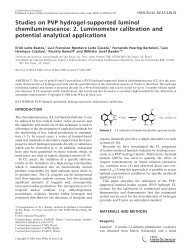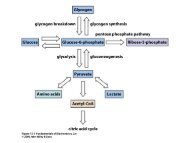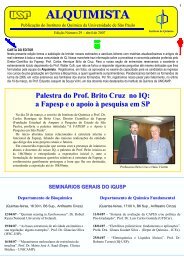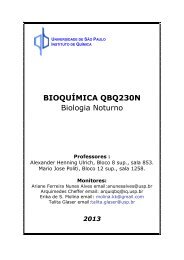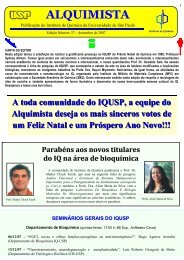Direct UV photocrosslinking of poly(N-vinyl-2-pyrrolidone) (PVP) to ...
Direct UV photocrosslinking of poly(N-vinyl-2-pyrrolidone) (PVP) to ...
Direct UV photocrosslinking of poly(N-vinyl-2-pyrrolidone) (PVP) to ...
Create successful ePaper yourself
Turn your PDF publications into a flip-book with our unique Google optimized e-Paper software.
L.C. Lopérgolo et al. / Polymer 44 (2003) 6217–6222 6221Fig. 3. Effect <strong>of</strong> irradiation dose and <strong>PVP</strong> concentration on the (A) swelling ratio at equilibrium, Q; (B) the number-average molecular weight betweencrosslinks, M c ; (C) crosslinking density, r x and (D) mesh size, j: (-B-) 40 mg/ml; (-X-) 60 mg/ml; (-O-) 80 mg/ml; (-P-) 120 mg/ml; (-V-) 200 mg/ml.needed (see Fig. 1). Hence, for such cases, mesh size wasfound <strong>to</strong> be around 4–6 nm.The swelling ratio at equilibrium depicts the maximumamount <strong>of</strong> water the hydrogel can hold, and again this is afunction <strong>of</strong> concentration and dose (Fig. 3(A)). Thisparameter is especially important in applications wheregels are used <strong>to</strong> absorb exudates, like wound dressings anddrug delivery devices. In the last case, the augment <strong>of</strong> meshsize due swelling is the prime control <strong>of</strong> delivery rate.The mechanical properties <strong>of</strong> the hydrogel were alsoanalyzed. The tensile strength ðT s Þ and elongation at breakðE b Þ were determined for a typical membrane used fordressing (3 mm thick) irradiated with 12.7 J, as a function <strong>of</strong><strong>PVP</strong> concentration. Table 1 lists the values found.While elongation at break did not present a significantvariation, the tensile strength was optimum for <strong>PVP</strong>concentration <strong>of</strong> 80–90 mg/ml, decreasing at higherconcentration. This can be explained by reviewing Fig.1(B), where it is clear that the gel fraction decreases athigher concentration, therefore compromising its mechanicalproperties.As compared <strong>to</strong> membranes produced by high-energyradiation, where tensile strength was found <strong>to</strong> be 0.02 MPafor the same concentration [15], the membrane herereported is ca. 30% weaker. However, even with thisdecrease in mechanical quality, the membrane still is quitestrong <strong>to</strong> be handled. Besides, other types <strong>of</strong> reinforcementmay be applied <strong>to</strong> suite its use [16].Table 1Mechanical properties <strong>of</strong> the hydrogel produced by <strong>UV</strong> radiation<strong>PVP</strong> conc.(mg/ml)gð%Þr x(10 25 mol/cm 3 )T s(10 23 MPa)E b(%)Fig. 4. Colony suppression curves <strong>of</strong> the hydrogel membranes produced bydifferent <strong>UV</strong> doses.[<strong>PVP</strong>] ¼ 80 g/l in water at room temperature. (—S—)288 J; (—A—) 389 J; (—W—) 777 J; (—K—) 1150 J; (—X—) negativecontrol (PVC); (—O—) positive control (phenol).80 84.5 ^ 0.6 3.47 ^ 3.4 12.3 ^ 2.1 54.5 ^ 5.190 – – 13.0 ^ 1.0 55.3 ^ 1.5100 – – 11.6 ^ 1.0 60.0 ^ 5.0120 80.9 ^ 2.1 3.36 ^ 5.3 10.2 ^ 1.2 62.0 ^ 6.9200 75.9 ^ 3.4 2.59 ^ 5.1 9.6 ^ 0.9 61.9 ^ 5.0Irradiation made on a quartz mold by pen-type lamp; irradiation dose1.8 kJ.
6222L.C. Lopérgolo et al. / Polymer 44 (2003) 6217–62223.3. Cy<strong>to</strong><strong>to</strong>xicity testsThe cy<strong>to</strong><strong>to</strong>xicity <strong>of</strong> the hydrogels prepared by allmethods was tested according <strong>to</strong> Ciapetti et al. [11]. Therelative count <strong>of</strong> <strong>to</strong>tal viable cells was correlated againsthydrogel extracts. For comparison, phenol was used as apositive control and <strong>poly</strong>(<strong>vinyl</strong> chloride) as a negativecontrol (Fig. 4). The conclusion from this experiment is thatthe hydrogels prepared by this method do not impose any<strong>to</strong>xic effect <strong>to</strong> live organisms.These hydrogels were also submitted <strong>to</strong> dermal inflammationtest [12] in albino rabbits, where dressings made <strong>of</strong>hydrogel were maintained in direct contact with the rabbitskin for 72 h. All samples presented inflammation indexeswithin a satisfac<strong>to</strong>ry range, i.e. as a non-irritating material.4. ConclusionsPho<strong>to</strong>crosslinking <strong>of</strong> <strong>PVP</strong> was confirmed as an inexpensivealternative for <strong>PVP</strong> hydrogel production. This can beachieved by direct irradiation using a low-pressure Hg lampeliciting 254 nm light. The material formed showed <strong>to</strong> bewell suited <strong>to</strong> all <strong>PVP</strong> hydrogel applications like wounddressings and drug delivery devices. The easy <strong>of</strong> itsproduction also opens the possibility <strong>of</strong> its use in situationswhere high-energy radiation is not available.AcknowledgementsThe authors would like <strong>to</strong> thank Dr Sizue O. Rogero andthe Institu<strong>to</strong> Adolfo Lutz for their contribution in thecy<strong>to</strong><strong>to</strong>xicity tests, the Fundação de Amparo a Pesquisa doEstado de São Paulo, FAPESP, São Paulo, Brazil, and theConselho Nacional de Desenvolvimen<strong>to</strong> Científico eTecnológico, CNPq, Brasília, Brazil, for financial support.References[1] Lee KY, Mooney DJ. Chem Rev 2001;101:1869–79.[2] H<strong>of</strong>fman AS. Adv Drug Deliv Rev 2002;43:3–12.[3] Rosiak JM, Yoshii F. Nucl Instr Methods Phys Res B 1999;151:56–64.[4] Nguyen KT, West JL. Biomaterials 2002;23:4307–14.[5] Rosiak J, Olejniaczak J, Pekala W. Radiat Phys Chem 1990;36:747–55.[6] Rosiak JM, Rucinska-Rybus A, Pekala W. US Patent No 4,871,490,1989.[7] Peppas NA, Barr-Howell BD. In: Peppas NA, edi<strong>to</strong>r. Characterization<strong>of</strong> the cross-linked structure <strong>of</strong> hydrogels. Hydrogels in medicine andpharmacy, vol. 1. Boca Ra<strong>to</strong>n: CRC Press; 1986. p. 27–56.[8] Hiemenz PC, Rajagopalan R. Principles <strong>of</strong> colloid and surfacechemistry, 3rd ed. New York: Marcel Dekker; 1997.[9] Rosiak JM, Olejniczak J. Radiat Phys Chem 1993;42:903–6.[10] Olejniczak J, Rosiak J, Charlesby A. Radiat Phys Chem 1991;37:499–504.[11] Ciapetti G, Granchi D, Verri E, Savarino L, Cavedagna D,Pizz<strong>of</strong>erra<strong>to</strong> A. Biomaterials 1996;17:1259–64.[12] Draize JH, Wooddard G, Calvery H. J Pharmacol Exp Ther 1944;83:377–90.[13] Sarkar A, Chakravorti S. J Chim Phys 1996;93:1281–91.[14] Charlesby A, Pinner J. A<strong>to</strong>mic radiation and <strong>poly</strong>mer. New York:Pergamon Press; 1960.[15] Miranda LF. In: Estudo de parametros de processo para a sintese demembranes hidr<strong>of</strong>ilicas a base de poli(N-vinil-2-pirrolidona). PhDThesis, University <strong>of</strong> Sao Paulo, 1999.[16] Lopergolo LC, Lugao AB, Catalani LH. J Appl Polym Sci 2002;86:662–6.


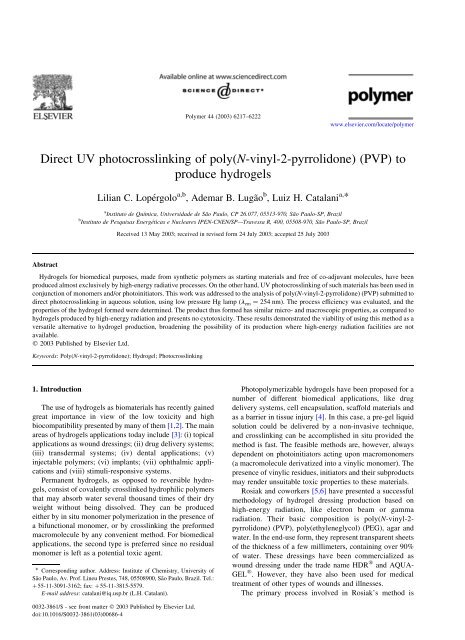
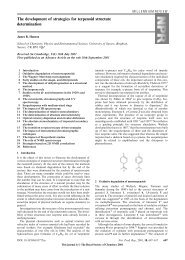
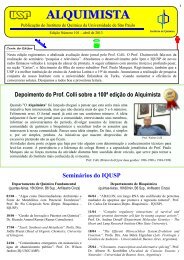
![PE]+ + N. Fragmentação por clivagem sigma](https://img.yumpu.com/50134385/1/180x260/pe-n-fragmentaaao-por-clivagem-sigma.jpg?quality=85)
